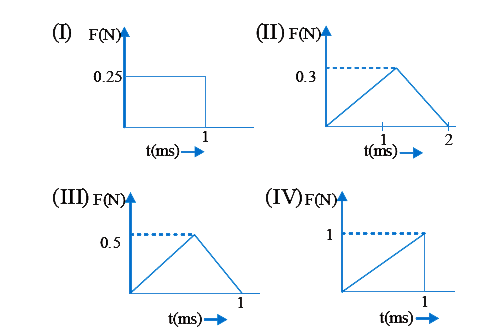If force F=500-100t, then function of impulse with time will be,-
500t−50t2
50t – 10
50–t2
100t2
The correct Answer is:A
To find the function of impulse with time given the force F=500−100t, we can follow these steps:
Step 1: Understand the relationship between force and impulse
Impulse is defined as the change in momentum, which can also be expressed as the integral of force over time:
Impulse=∫Fdt
Step 2: Substitute the given force into the impulse formula
Given the force F=500−100t, we substitute this into the impulse formula:
Impulse=∫(500−100t)dt
Step 3: Integrate the force function
Now we will perform the integration:
Impulse=∫(500−100t)dt=∫500dt−∫100tdt
Calculating each integral separately:
1. ∫500dt=500t
2. ∫100tdt=50t2 (using the power rule of integration)
Combining these results, we have:
Impulse=500t−50t2+C
where C is the constant of integration.
Step 4: Write the final expression for impulse
Since we are looking for the function of impulse with respect to time, we can ignore the constant C for this context. Thus, the function of impulse with time is:
Impulse(t)=500t−50t2
Final Answer
The function of impulse with time is:
Impulse(t)=500t−50t2
---
Impulse is defined as the change in momentum, which can also be expressed as the integral of force over time:
Impulse=∫Fdt
Given the force F=500−100t, we substitute this into the impulse formula:
Impulse=∫(500−100t)dt
Now we will perform the integration:
Impulse=∫(500−100t)dt=∫500dt−∫100tdt
1. ∫500dt=500t
2. ∫100tdt=50t2 (using the power rule of integration)
Impulse=500t−50t2+C
where C is the constant of integration.
Since we are looking for the function of impulse with respect to time, we can ignore the constant C for this context. Thus, the function of impulse with time is:
Impulse(t)=500t−50t2
The function of impulse with time is:
Impulse(t)=500t−50t2
Similar Questions
Knowledge Check
Assertion: There is no apprecible change in the position of the body during the action of the impulsive force.
Reason: In case of impulsive force the time of action of the force is very short.AIf both assertion and reason are true and reason is the correct explanation of assertion.BIf both assertion and reason are true and reason is the not correct explanation of assertion.CIf assertion is true but reason is falseDIf both assertion and reason are false.
Figures I,II, III & IV depicts variation of force with time. In which situation impulse will be maximum ?

View SolutionThe magnitude of the force (in newtons) acting on a body varies with time t (in micro seconds) as shown in the fig AB, BC and CD are straight line segments. The magnitude of the total impulse of the force on the body from t=4μs to t=16μs is ….Ns

View SolutionA gun applies a force F on a bullet which is given by F=(100−0.5×105t)N. The bullet emerges out with speed 400 m/s. then find out the impulsive exerted till force on bullet becomes zero.
View SolutionThe displacement - time (x−t) graph of a particle executing simple harmonic motion is shown in figure. The correct variation of net force F action on the particle as a function of time is

View SolutionA block of mass m at rest is acted upon by a force F for a time t. The kinetic energy of block after time t is
View SolutionA force F is applied to the initially stationary cart. The variation of force with time is shown in the figure. The speed of cart at t = 5 sec is

View SolutionA force F of constant magnitude acts on a block of mass 'm' and t=0,initially along positive x-direction. The direction of force F starts rotating with a constant angular velocity ω in anticlockwise sense. Then the magnitude of velocity of the block as a function of time 't' is ( initial block was at rest )
View Solution